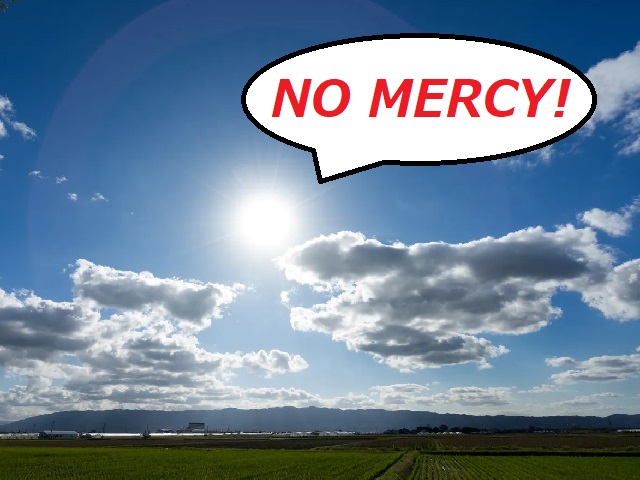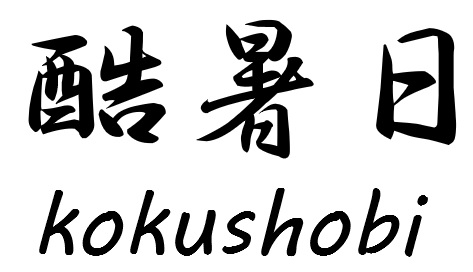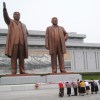
Sometimes “Atsui!” just isn’t enough.
In Japanese, the word for “hot” (as in hot weather) is atsui. But when there’s a day or night that’s really hot, there are actually official government terms for them.
According to the Japan Meteorological Agency (part of the the Ministry of Land, Infrastructure, Transport and Tourism), if the temperature rises above 35 degrees Celsius (95 degrees Fahrenheit), then it’s classified as a moushobi, or “ferocious heat day.” Meanwhile, if even the nighttime low is still above 25 Celsius (77 Fahrenheit), then we’re having a nettaiya, or “tropical night.”
▼ Sadly, the government has yet to enact a policy to distribute emergency rations of refreshing tropical drinks on “tropical nights.”
But what about when things get even hotter? The government’s terminology caps out at those 35/25-degree thresholds, so the Japan Weather Association, a non-government meteorological association, took it upon itself to come up with new terms through a poll of 140 of the organization’s members.
After tallying the responses, the association has dubbed days with a high temperature of over 40 degrees Celsius (104 degrees Fahrenheit) kokushobi, or “cruel heat days.”
And for those nights that go beyond nettaiya? Here the Japan Weather Association decided to keep things descriptive and simple, with the survey deciding that if the overnight low never dips below 30 Celsius (86 Fahrenheit), then it’s a chounettaiya, or “super tropical night.”
Thankfully, neither kokushobi nor chounettaiya are all that common in Japan. Since the start of modern record keeping in 1875, there have only been 67 recorded incidences of temperatures above 40 degrees Celsius, observed at a total of 32 locations, mostly in the Kanto and Tokai regions of east and central-east Japan. Super tropical nights are even rarer, having been observed only 15 times in 11 locations, almost all of them in the Hokuriku region which runs along the north-facing coast of Japan’s main island of Honshu (Niigata Prefecture has had seven recorded chounettaiya, and no other prefecture more than two).
However, records show only eight kokushobi occurrences prior to the year 2000, with 40 occurring since 2018 and the most recent in June of this year. We may end up seeing another before the summer ends, and the Japan Weather Association is cautioning everyone to be aware of the temperature and take adequate measures to prevent dehydration and heat exhaustion.
Source: Tenki.jp via Hachima Kiko
Top image: Pakutaso (edited by SoraNews24)
Insert images ©SoraNews24
● Want to hear about SoraNews24’s latest articles as soon as they’re published? Follow us on Facebook and Twitter!
Follow Casey on Twitter, where he can’t hear the word “nettaiya” without being reminded of the Orange Range song of the same name.




 How to dress for the weather: A guide from Japan
How to dress for the weather: A guide from Japan It’s so hot in Japan that people are cooking food in/on their cars【Photos】
It’s so hot in Japan that people are cooking food in/on their cars【Photos】 This is the best summer in years to visit Japan…if you hate mosquitoes
This is the best summer in years to visit Japan…if you hate mosquitoes Summer in Japan doesn’t feel like a Japanese summer this year, many are saying
Summer in Japan doesn’t feel like a Japanese summer this year, many are saying Monday was the hottest day ever in Japan’s recorded history
Monday was the hottest day ever in Japan’s recorded history Foreign driver’s license conversion test passes plummet from over 90% to 33% in Japan
Foreign driver’s license conversion test passes plummet from over 90% to 33% in Japan Chinese government’s don’t-go-to-Japan warning has heartwarming non-effect on Yokohama Chinatown
Chinese government’s don’t-go-to-Japan warning has heartwarming non-effect on Yokohama Chinatown Nintendo releases Metroid-shaped ice cube/cooking tray and Samus arm cannon pillow【Pics】
Nintendo releases Metroid-shaped ice cube/cooking tray and Samus arm cannon pillow【Pics】 Duolingo to open first pop-up store Duomart in Japan for a very limited time next month
Duolingo to open first pop-up store Duomart in Japan for a very limited time next month Popular Japanese ramen restaurant Ichiran’s lucky bags are great value for money
Popular Japanese ramen restaurant Ichiran’s lucky bags are great value for money You can now buy a Japanese train station clock in Japan
You can now buy a Japanese train station clock in Japan KFC Japan opens a Christmas restaurant in Tokyo…but why???
KFC Japan opens a Christmas restaurant in Tokyo…but why??? Starbucks Japan now offers close-to-closing discounted items through its mobile order app
Starbucks Japan now offers close-to-closing discounted items through its mobile order app Burger King Japan’s newest all-you-can-eat burger deal is its smelliest yet
Burger King Japan’s newest all-you-can-eat burger deal is its smelliest yet “Let’s Speak North Korean!”
“Let’s Speak North Korean!” Japan’s human washing machines will go on sale to general public, demos to be held in Tokyo
Japan’s human washing machines will go on sale to general public, demos to be held in Tokyo Japanese train company is letting fans buy its actual ticket gates for their homes
Japanese train company is letting fans buy its actual ticket gates for their homes Yoshinoya adds first-ever chain-wide ramen with new beef and pork-broth noodle hot pot meals
Yoshinoya adds first-ever chain-wide ramen with new beef and pork-broth noodle hot pot meals Nintendo’s Kirby now delivering orders at Kura Sushi restaurants, but not in Japan
Nintendo’s Kirby now delivering orders at Kura Sushi restaurants, but not in Japan Is China’s don’t-go-to-Japan warning affecting tourist crowds in Shibuya’s Don Quijote?
Is China’s don’t-go-to-Japan warning affecting tourist crowds in Shibuya’s Don Quijote? Japan considering raising international traveler departure tax even more than previously reported
Japan considering raising international traveler departure tax even more than previously reported Is China’s don’t-go-to-Japan warning affecting tourist crowd sizes in Nara?
Is China’s don’t-go-to-Japan warning affecting tourist crowd sizes in Nara? Studio Ghibli stamps lift your spirits with motivational phrases from Totoro
Studio Ghibli stamps lift your spirits with motivational phrases from Totoro New fish discovered and named “Vanderhorstia supersaiyan” for obvious reasons
New fish discovered and named “Vanderhorstia supersaiyan” for obvious reasons Japanese town suing resident for being a jerk
Japanese town suing resident for being a jerk Starbucks Japan unveils new Christmas goods and a rhinestone tumbler that costs 19,500 yen
Starbucks Japan unveils new Christmas goods and a rhinestone tumbler that costs 19,500 yen Real-world Nausicaa Ghibli anime glider completes its final flight in Japan【Video】
Real-world Nausicaa Ghibli anime glider completes its final flight in Japan【Video】 Brand-new Pokémon park opens in Japan with larger-than-life-size Lapras【Photos】
Brand-new Pokémon park opens in Japan with larger-than-life-size Lapras【Photos】 Unique inclined elevator in Japan leads to a town that inspired Studio Ghibli’s Spirited Away
Unique inclined elevator in Japan leads to a town that inspired Studio Ghibli’s Spirited Away Is China’s don’t-go-to-Japan warning affecting tourist crowds in Tokyo’s Asakusa neighborhood?
Is China’s don’t-go-to-Japan warning affecting tourist crowds in Tokyo’s Asakusa neighborhood? The 10 best day trips from downtown Tokyo【Survey】
The 10 best day trips from downtown Tokyo【Survey】 Naturally brown-haired Osaka student sues government for forcing her to dye her hair black
Naturally brown-haired Osaka student sues government for forcing her to dye her hair black Tokyo hotel lets you make your stay a Sanrio one with special My Melody and Kuromi rooms【Pics】
Tokyo hotel lets you make your stay a Sanrio one with special My Melody and Kuromi rooms【Pics】 Survey asks foreign tourists what bothered them in Japan, more than half gave same answer
Survey asks foreign tourists what bothered them in Japan, more than half gave same answer Japan’s deadliest food claims more victims, but why do people keep eating it for New Year’s?
Japan’s deadliest food claims more victims, but why do people keep eating it for New Year’s? We deeply regret going into this tunnel on our walk in the mountains of Japan
We deeply regret going into this tunnel on our walk in the mountains of Japan Studio Ghibli releases Kodama forest spirits from Princess Mononoke to light up your home
Studio Ghibli releases Kodama forest spirits from Princess Mononoke to light up your home Major Japanese hotel chain says reservations via overseas booking sites may not be valid
Major Japanese hotel chain says reservations via overseas booking sites may not be valid Put sesame oil in your coffee? Japanese maker says it’s the best way to start your day【Taste test】
Put sesame oil in your coffee? Japanese maker says it’s the best way to start your day【Taste test】 The top 10 annoying foreign tourist behaviors on trains, as chosen by Japanese people【Survey】
The top 10 annoying foreign tourist behaviors on trains, as chosen by Japanese people【Survey】 No more using real katana for tourism activities, Japan’s National Police Agency says
No more using real katana for tourism activities, Japan’s National Police Agency says J-pop mega star Ado reveals she’s been living in the U.S., may not understand language acquisition
J-pop mega star Ado reveals she’s been living in the U.S., may not understand language acquisition Heat sake like they do at a Japanese izakaya with this special at-home set
Heat sake like they do at a Japanese izakaya with this special at-home set Japan’s intense heat wave has killed 79 people in Tokyo
Japan’s intense heat wave has killed 79 people in Tokyo Japanese summer is worse than summer in Death Valley, says our correspondent, a seasoned traveler
Japanese summer is worse than summer in Death Valley, says our correspondent, a seasoned traveler Japan’s first snowfall of the season comes to Hokkaido before September ends【Video, photos】
Japan’s first snowfall of the season comes to Hokkaido before September ends【Video, photos】 As summer comes to an end, it’s time to get ready for a plague of mosquitoes in Japan
As summer comes to an end, it’s time to get ready for a plague of mosquitoes in Japan Japan’s new wearable air conditioner belt is here just in time for the Tokyo heat wave
Japan’s new wearable air conditioner belt is here just in time for the Tokyo heat wave W.T.F. Japan: Top 5 odd ways Japanese people beat the summer heat【Weird Top Five】
W.T.F. Japan: Top 5 odd ways Japanese people beat the summer heat【Weird Top Five】 Japanese clothing companies adopt fifth “Intense Heat” season because summer is too long
Japanese clothing companies adopt fifth “Intense Heat” season because summer is too long Summer in Japan doesn’t sound like summer in Japan right now
Summer in Japan doesn’t sound like summer in Japan right now Our reporter devises the best way to beat the summer heat: by eating somen in an outdoor shower
Our reporter devises the best way to beat the summer heat: by eating somen in an outdoor shower Twin-tailed flasher in Japan’s coldest prefecture may not understand how flashing works
Twin-tailed flasher in Japan’s coldest prefecture may not understand how flashing works We cook a monjayaki Japanese pancake on the hood of a car during Japan’s hottest summer ever【Vid】
We cook a monjayaki Japanese pancake on the hood of a car during Japan’s hottest summer ever【Vid】 You can make your own hot spring bath at this river in central Japan【Japan travel】
You can make your own hot spring bath at this river in central Japan【Japan travel】 Midwinter “cherry blossoms” are making one of Japan’s best castles even more stunning【Photos】
Midwinter “cherry blossoms” are making one of Japan’s best castles even more stunning【Photos】 We dip our feet into a Japanese onsen…inside footbath boots
We dip our feet into a Japanese onsen…inside footbath boots Do the new Uniqlo summer face masks really deserve bad reviews?
Do the new Uniqlo summer face masks really deserve bad reviews?
Leave a Reply